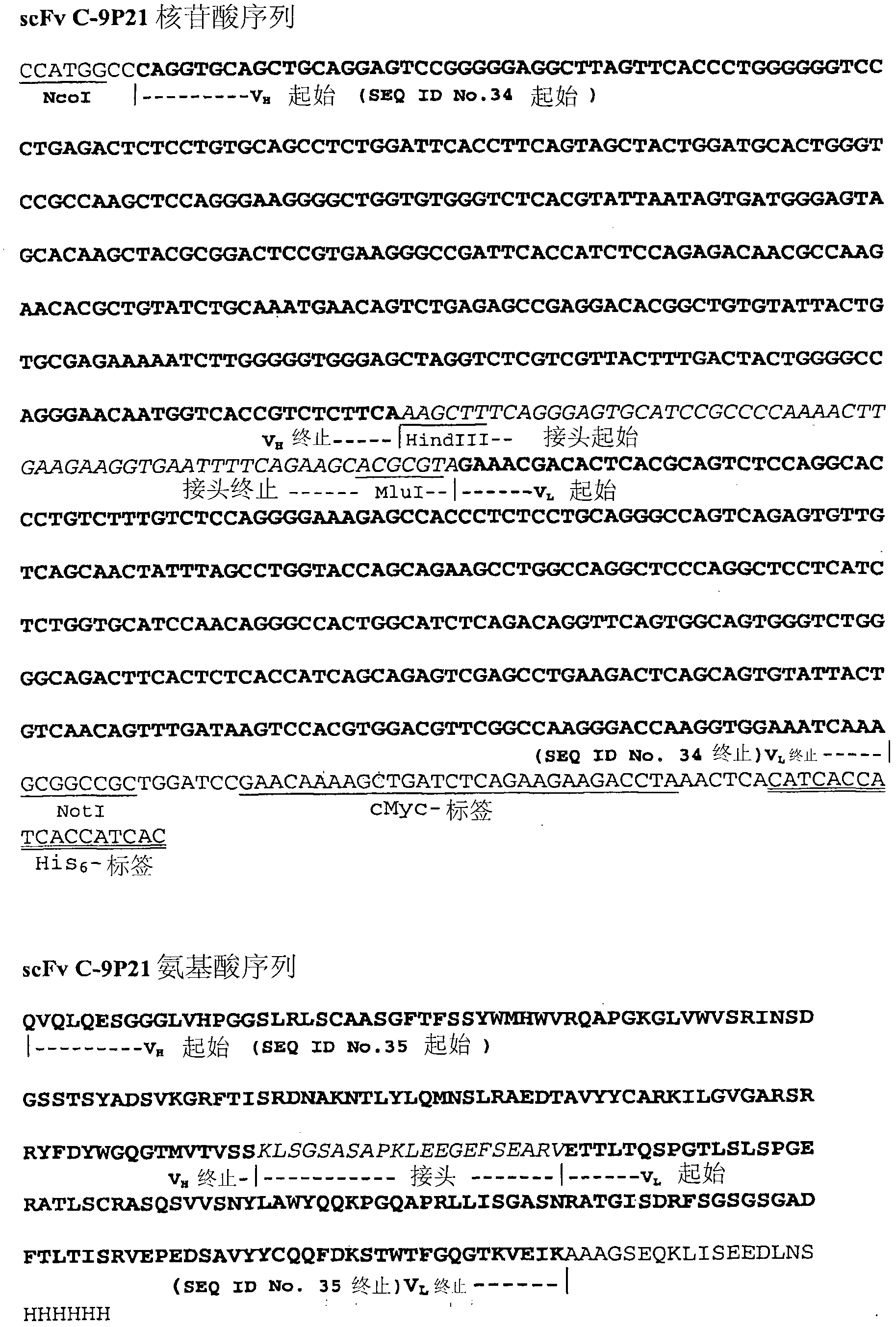Antibodies
A technology of antibody and human antibody, which is applied in the field of antibody binding to CXCR4, to achieve a favorable and safe effect
- Summary
- Abstract
- Description
- Claims
- Application Information
AI Technical Summary
Problems solved by technology
Method used
Image
Examples
Embodiment 1
[0622] Example 1: Novel Antibody
[0623] Five human antibodies that could specifically bind to CXCR4 were identified. The single-chain form of the antibody was cloned into the pHOG21 plasmid containing c-myc and the 6xHis tag epitope (Kipryanov et al., 1997). TG1 bacteria were transformed and expressed scFv after IPTG induction. Binding of purified antibodies was confirmed by EasyCyte.
[0624] The nucleotide sequences of the heavy and light chains of the antibodies from which the clones were generated were sequenced. Antibodies were designated C-9P21, B-1M22, C-1I24, D-1K21 and 9N10. The nucleotide sequence and amino acid sequences of the light and heavy chains of C-9P21 are shown in figure 1 . The CDR regions of the light and heavy chains of C-9P21 are shown in Table 1. The nucleotide sequence and amino acid sequences of the light and heavy chains of B-1M22 are shown in figure 2 . The CDR regions of the light and heavy chains of B-1M22 are shown in Table 2. The n...
Embodiment 2
[0632] Example 2: Binding specificity of antibody clones to CXCR4 expressing cells
[0633] Four antibodies, B-1M22, C-9P21, C-1124 and D-1K21, were tested for their CXCR4 specificity at the scFv level by their ability to bind CXCR4 expressing cells. Transformed cells differed from their untransformed counterparts only in the expression of CXCR4.
[0634] Materials and methods
[0635] DT40 and HEK293T / 17 cells were maintained as described above.
[0636]DT40+CXCR4, HEK293T / 17+CXCR4, DT40 and HEK293T / 17 cells were collected from culture flasks, washed twice with PBS (400xg, 5min, 4°C) and resuspended in a medium containing 0.2% BSA and 0.09% NaN 3 in the PBS. 1x10 5 Cells / well were aliquoted into V-shaped 96-well plates (Greiner Bio-One, Frikenhausen, Germany). Cells were centrifuged (400x g, 5 min, 4°C) and resuspended in 50 μl ScFvs (10 μg / ml) in PBS (containing 0.2% BSA and 0.09% NaN 3 ). After incubation for 1 hour (4°C), the cells were washed with 100 μl PBS (c...
Embodiment 3
[0645] Example 3: Anti-CXCR4 antibodies interfere with ligand binding
[0646] Four antibodies B-1M22, C-9P21, C-1I24 and D-1K21 bind to CXCR4-transfected cells and constitutively through them at the scFv level in the presence and absence of two molecules that specifically bind to CXCR4 The ability of CXCR4-expressing lymphoblastoid cells to test their CXCR4 specificity. One molecule is SDF-1, the natural ligand of CXCR4, and the other is AMD3100, a highly specific competitive inhibitor of SDF-1α binding to CXCR4.
[0647] Materials and methods:
[0648] Jurkat and Ramos cells were maintained as described above.
[0649] The scFv clones were expressed on a large scale and purified as monomeric fractions by SEC fractionation. Harvest native CXCR4+ expressing cell lines Jurkat and Ramos from culture flasks, wash with PBS (with 0.2% BSA and 0.09% NaN 3 Buffer replenishment) washed 2 times and with 1x10 5 Cells / well were aliquoted into V-shaped 96-well plates (Greiner Bio...
PUM
 Login to View More
Login to View More Abstract
Description
Claims
Application Information
 Login to View More
Login to View More - R&D
- Intellectual Property
- Life Sciences
- Materials
- Tech Scout
- Unparalleled Data Quality
- Higher Quality Content
- 60% Fewer Hallucinations
Browse by: Latest US Patents, China's latest patents, Technical Efficacy Thesaurus, Application Domain, Technology Topic, Popular Technical Reports.
© 2025 PatSnap. All rights reserved.Legal|Privacy policy|Modern Slavery Act Transparency Statement|Sitemap|About US| Contact US: help@patsnap.com



